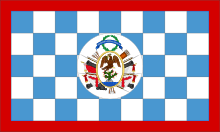Amelia Island affair
The Amelia Island affair was an episode in the history of colonial Florida under Spanish rule.
The Embargo Act (1807) and the abolition of the American slave trade (1808) made Amelia Island, on the coast of northeastern Florida, a resort for smugglers with sometimes as many as 150 square-rigged vessels in its harbor.[1] In June, 1817, Gregor MacGregor, a Scottish adventurer styling himself the "Brigadier General of the United Provinces of New Granada and Venezuela and General-in-Chief of the Armies of the Two Floridas", came to Amelia Island. A peripatetic military adventurer, MacGregor, purportedly commissioned by Simon Bolivar, had raised funds and troops for a full-scale invasion of Florida, but squandered much of the money on luxuries; as word of his conduct in the South American wars reached the United States, many of the recruits in his invasion force deserted. Nonetheless, he overran the island with a small force, but left for Nassau in September.

His followers were soon joined by Louis-Michel Aury, formerly associated with MacGregor in South American adventures,[2] and previously one of the leaders of a group of buccaneers on Galveston Island, Texas.[3][4][5] Aury assumed control of Amelia,[6] created an administrative body called the "Supreme Council of the Floridas",[7] directed his secretaries Pedro Gual and Vicente Pazos to draw up a constitution,[8] and invited all Florida to unite in throwing off the Spanish yoke. For the few months that Aury controlled Amelia Island,[9] the flag of the revolutionary Republic of Mexico was flown.[10] This was the flag of his supposed clients who were still fighting the Spanish in their war for independence at that time. The United States, which had plans to annex the peninsula, sent a naval force which captured Amelia Island on December 23, 1817.[11]
References
- ↑ James Willard Milgram (July 1961). "A Florida Cover under American Occupation of Spanish Territory". Florida Historical Quarterly. Florida Historical Society. 40 (1): 94. JSTOR 30139819.
But beginning with 1808, because of Jefferson's Embargo Act, Fernandina became a thriving port with more business than even St. Augustine. The reason was that from it, merchants had easy access to the states and smuggling became a most profitable business. At one time it was stated that there were more than 150 ships in the harbor.
- ↑ John Quincy Adams (1875). Memoirs of John Quincy Adams: Comprising Portions of His Diary from 1795 to 1848. J.B. Lippincott & Company. p. 75.
- ↑ Natalie Ornish (1 September 2011). Pioneer Jewish Texans. Texas A&M University Press. p. 17. ISBN 978-1-60344-433-0.
- ↑ David G. McComb (1 January 2010). Galveston: A History. University of Texas Press. pp. 43–44. ISBN 978-0-292-79321-7.
- ↑ Frank L. Owsley; Gene A. Smith (22 March 2004). Filibusters and Expansionists: Jeffersonian Manifest Destiny, 1800-1821. University of Alabama Press. p. 136. ISBN 978-0-8173-5117-5.
- ↑ James L. Erwin (2007). Declarations of Independence: Encyclopedia of American Autonomous and Secessionist Movements. Greenwood Publishing Group. p. 47. ISBN 978-0-313-33267-8.
- ↑ David Head (1 October 2015). Privateers of the Americas: Spanish American Privateering from the United States in the Early Republic. University of Georgia Press. p. 107. ISBN 978-0-8203-4400-3.
- ↑ Judith Ewell (1996). Venezuela and the United States: From Monroe's Hemisphere to Petroleum's Empire. University of Georgia Press. p. 250. ISBN 978-0-8203-1782-3.
- ↑ Rafe Blaufarb (2005). Bonapartists in the Borderlands: French Exiles and Refugees on the Gulf Coast, 1815-1835. University of Alabama Press. p. 250. ISBN 978-0-8173-1487-3.
- ↑ Richard G. Lowe (July 1966). "American Seizure of Amelia Island". The Florida Historical Quarterly. 45 (1): 22. JSTOR 30145698.
- ↑ British and Foreign State Papers. H.M. Stationery Office. 1837. pp. 756–757.